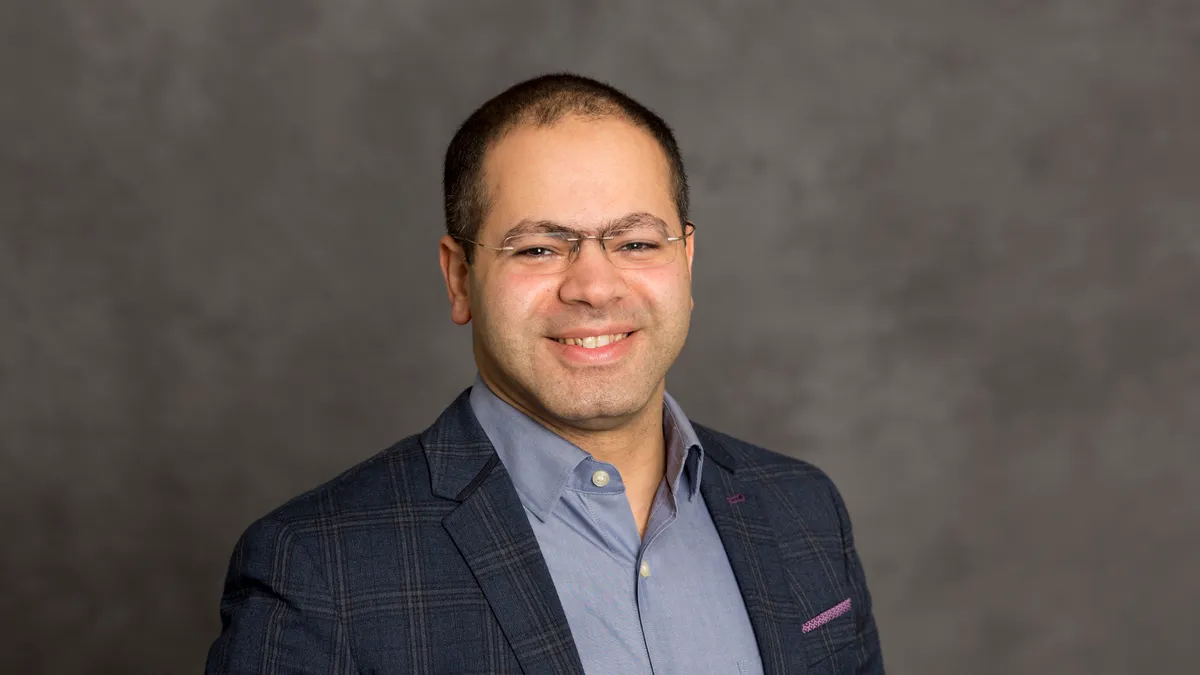In Construction Dive's new ConTech Conversations, editors sit down with industry leaders to learn more about tech adoption, innovation and what the future holds. Do you have an idea for a contech expert we should talk to? Email [email protected].
Autodesk named Amr Raafat the Innovator of the Year in 2019 for his implementation of drone mapping technology on sites for Windover Construction in New England. Construction Dive spoke with Raafat, Windover’s vice president of VDC and technology, to learn more about the innovator’s thoughts on the industry’s tech standards and what lies ahead.
Editor’s Note: The following interview has been edited for brevity and clarity.
CONSTRUCTION DIVE: What do you think is the most important way that contractors can get up to speed in this environment where everyone seems to be dragging their feet in adopting tech?
AMR RAAFAT: In my opinion, the thing that contractors can do to catch up is create a culture that helps folks be willing to embrace new technologies, and that's what we have here at Windover. Folks on the site, superintendents and project managers are all willing to embrace new technologies, and are open to new ideas to help them build better and safer with the technology we have right now.
So, the most important thing is to really create a culture in construction companies that will help folks be willing to adopt tech. And as soon as we have that, all the doors would be open, new technologies will be tried on jobsites and we'll definitely advance the industry.
What is something that people can do to start opening those doors?
RAAFAT: I believe it comes down to more communication between technology groups in the company. For instance, I meet regularly with our superintendents, our field teams. Those guys are key. The more communication between the technology experts or the [virtual design and construction, or VDC] and BIM experts with the field team, the more that helps us initiate conversations about the challenges we have on site.
And we have so many offerings in emerging technology offerings like drones, laser scanners and now robotics, all of that. I listen to their challenges, learn more about them, and then respond with a solution. So, really more communication between the VDC team with the field team. That's where great ideas will be born and solutions developed for construction.
Are you confronting challenges by finding new tech solutions or are you discovering tech solutions and applying them to solve challenges?
RAAFAT: That's a great question. It's almost like the egg or the chicken. In my experience here at Windover, when the teams come, whether it's a project manager or a superintendent, they tell you they have a challenge. Like, for example, “We have those anchor bolts on the site and we need to identify the as-built anchor bolts before we place the steel.” So, I'm not sure how we would do that, initially. And then because I have these offerings at my disposal, I have in the back of my mind, "Oh, we have laser scanner, we can do laser scanning. We have the drone that can look from above and capture this from above." Then that's the solution.
The first step that comes is that we know which technology could be useful, we master it and then the time will come. It's got to be ready in our pocket and then when the time comes, we’ll need a solution within a couple of days. If we offer it to them the next week, maybe that's too late. So, I think first mastering the technology offerings and then realizing what you can do with it is best. Professionals should be able to offer the solution in real time using the arsenal of the technological offerings they have in house. That's my opinion. You could have the technology ready. Then, when the challenge arrives onsite, you're ready to offer the solution.
What do you consider the best practices for fully vetting new technology or a new solution before implementing it onsite?
RAAFAT: Tech has got to be tested and exercised on sites with real-time challenges and problems. Like for example: 3D printing. We were renovating a historic facade in New England and we needed to create an exact replica of this 120-year-old facade. I was sitting in a meeting and I said, “Okay, I know I can work in Autodesk, and every day we do a laser scan, so how about we do laser scans of that facade and 3D print it at Autodesk’s technology center?”
I hadn’t done a project like that before, and it was actually done in an unprecedented way. Before folks would do a cast in the 3D printer of that facade. We had the basics that we could use to make that work: expertise with laser scanning and with 3D modeling. And now we have a 3D model of the facade. So, the best way is to practice on real-time projects.
What tech do you see on jobsites in five to 10 years?
RAAFAT: That's a very tough question. Ten years ago I didn't think that we would be doing drone mapping, for example. And now we are using the drone mapping combined with laser scanning on almost every Windover job. As we have been doing this, we were one of the very early implementers of drone mapping and laser scanning in the industry across the country.
Now, folks are catching up, which is great to see. I think 10 years from now, I'm expecting that robotics will play a big role. We already are experimenting with that, I expect that robotics will be the future. And again it's not going to be robotics by itself. It's going to be robotics combined with laser scanning with BIM coordination. Robotics will be the catalyst. So I think definitely robotics will be the future for the next 15 years and it's going to help us save time and money and build safer.






















